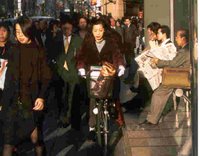
August 16, 2008. On that day the United Nations predicts that, for the first time, there will be more urban than rural dwellers.
On that day earth will have 3, 349,383,005 (give or take a few million) people living in the world's cities, the start of what's being called the "urban age."
It's a trend that's not expected to stop any time soon. By 2030 it's estimated that urban dwellers will exceed the rural population two to one. According to Reuters UK:
"'We live in an age of unprecedented, rapid, irreversible urbanisation,' said Anna Tibaijuka, head of the U.N. Human Settlements Programme U.N.-HABITAT. 'The cities growing fastest are those of the developing world, and the fastest-growing neighbourhoods are the slums.'
"One billion people -- a sixth of humanity -- live in slums.
"This population shift will lead to a new kind of city -- "mega cities" with more than 10 million people will soon be eclipsed by "hyper cities" with more than 20 million.
"So far, only Tokyo qualifies as a "hyper city" but the greater city areas of Mumbai, Lagos, Dhaka and Sao Paulo will also surpass 20 million by 2015, according to U.N. projections.
"The trend to urbanisation may be irreversible, but cities and towns are not eternal:
"Babylon, Troy, and Machu Picchu have come and gone; other cities have been destroyed by sieges, bombs or natural disasters like earthquakes, fire and disease. Some like Rome have been rebuilt on the ruins of former grandeur.
"New threats are emerging all the time: the September 11, 2001 attacks in the United States exposed modern cities' vulnerability to a handful of suicidal hijackers.
"Then there are the human risks: the United Nations has warned that the growing number of poor slum dwellers is a ticking time bomb that governments dare not ignore. "
No comments:
Post a Comment